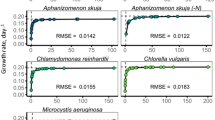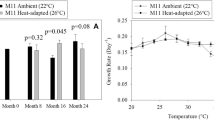Abstract
We chose four species of freshwater phytoplankton: the chlorophyceans Ankistrodesmus falcatus, Chlamydomonas reinhardtii and Selenastrum capricornutum, and the cyanobacteria Oscillatoria sp. in order to study their competitive abilities for nitrate and their allelopathic properties. We parameterized models of nitrate uptake and growth with laboratory experiments. According to them, the species were ranked (from the best to the worst competitors): S. capricornutum, C. reinhardtii, A. falcatus and Oscillatoria sp. C. reinhardtii and Oscillatoria sp. were previously reported as allelopathic. In the present work, Oscillatoria sp. was allelopathic only against A. falcatus. However, none of our species was sensitive to C. reinhardtii. Additionally, we found an unknown allelopathic effect of A. falcatus against Oscillatoria sp. Our findings point out the high specificity of allelopathic interactions. With these data, we constructed a model of interspecific competition for nitrate, including allelopathic interactions. By performing model simulations, we studied how three factors influence the outcome of competition: relative abundance of competing species, resistance to allelopathy, and nitrate concentration. Our simulations showed that the initial ratio of species abundances will significantly determine the outcome of competition. If the worst competitor was the allelopathic species, the more it needs to outnumber the competing species, unless it is very sensitive to allelopathy (not defended). Nitrate has an important influence, showing a non-intuitive outcome of competition experiments at low nitrate concentrations, where the worst competitor (allelopathic species) wins competition in the majority of cases, whereas at intermediate concentrations, the better competitor dominates except for unfavorable ratios of abundances. With the increased amounts of nitrate, conditions again favor the worst competitor (the stronger allelopathic species). Despite the potential for two species coexistence showed by previous theoretical analysis of systems was similar to ours, our simulations did not detect this outcome. We hypothesized that this is due to the strong allelopathic effect of Oscillatoria sp.




Similar content being viewed by others
References
Barreiro A, Hairston NG Jr (2013) The effects of resource limitation on the allelopathic effect of Chlamydomonas reinhardtii on other unicellular freshwater planktonic organisms. J. Plankt Res 35:1339–1344
Boit A, Martinez ND, Williams RJ, Gaedke U (2012) Mechanistic theory and modelling of complex food-web dynamics in Lake Constance. Ecol Lett 15:594–602
Chao L, Levin BR (1981) Structured habitats and the evolution of anticompetitor toxins in bacteria. Proc Natl Acad Sci USA 78:6324–6328
Durret R, Levin S (1997) Allelopathy in spatially distributed populations. J Theor Biol 185:165–171
Fistarol GO, Legrand C, Selander E, Hummer C, Stolte W, Granéli E (2004) Allelopathy in Alexandrium spp.: effect on a natural plankton community and on algal monocultures. Aquat Microb Ecol 35:45–56
Granéli E, Weberg M, Salomon PS (2008) Harmful algal blooms of allelopathic microalgal species: the role of eutrophication. Harmful Algae 8:94–102
Hattenrath-Lehmann TK, Gobler CJ (2011) Allelopathic inhibition of competing phytoplankton by North American strains of the toxic dinoflagellate, Alexandrium fundyense: evidence from field experiments, laboratory experiments, and bloom events. Harmful Algae 11:106–116
Hiltunen TJ, Barreiro A, Hairston NG Jr (2012) Mixotrophy and the toxicity of Ochromonas in a pelagic food web. Freshw Biol 57:2262–2271
Hsu SB, Waltman P (2004) A survey of mathematical models of competition with an inhibitor. Math Biosci 187:53–91
Huisman J, Sharples J, Stroom JM, Visser PM, Kardinaal WEA, Verspagen JMH, Sommeijer B (2004) Changes in turbulent mixing shift competition for light between phytoplankton species. Ecology 85:2960–2970
Hulot FD, Huisman J (2004) Allelopathic interactions between phytoplankton species: the roles of heterotrophic bacteria and mixing intensity. Limnol Oceanogr 49:1424–1434
Hutchinson GE (1961) The paradox of the plankton. Am Nat 95:137–145
Ianora A, Bentley MG, Caldwell GS, Casotti R, Cembella AD, Engström-Öst J, Halsband C, Sonnenschein E, Legrand C, Llewellyn CA, Paldavičienë A, Pilkaityte R, Pohnert G, Razinkovas A, Romano G, Tillmann U, Vaiciute D (2011) The relevance of marine chemical ecology to plankton and ecosystem function: an emerging field. Mar Drugs 9:1625–1648
International Allelopathy Society (1996) Constitution. Drawn up during the First World Congress on Allelopathy: A science for the future. Cadiz, Spain. http://www-ias.uca.es/bylaws.htm#CONSTIIAS
Jonsson PR, Pavia H, Toth G (2009) Formation of harmful algal blooms cannot be explained by allelopathic interactions. Proc Nat Acad Sci USA 107:11177–11182
Kubanek J, Hicks MK, Naar J, Villareal TA (2005) Does the red tide dinoflagellate Karenia brevis use allelopathy to outcompete other phytoplankton? Limnol Oceanogr 50:883–895
Leão PN, Vasconcelos MTSD, Vasconcelos VM (2009) Allelopathic activity of cyanobacteria on green microalgae at low cell densities. Eur J Phycol 44:347–355
Leão PN, Pereira AR, Wei-Ting Liuc NJ, Pevzner PA, Dorrestein PC, König GM, Vasconcelos VM, Gerwick WH (2010) Synergistic allelochemicals from a freshwater Cyanobacterium. Proc Nat Acad Sci (USA) 107:11183–11188
LeBlanc S, Pick FR, Aranda-Rodríguez R (2005) Allelopathic effects of the toxic cyanobacterium Microcystis aeruginosa on duckweed, Lemna gibba L. Environ Toxicol 20:67–73
Legrand C, Rengefors K, Fistarol GO, Granéli E (2003) Allelopathy in phytoplankton-biochemical, ecological and evolutionary aspects. Phycologia 42:406–419
Margalef R (1978) Life-forms of phytoplankton as a survival alternatives under an unstable environment. Oceanol Acta 1:493–509
Martines IP, Boukharov HV, Grover JP (2009) A chemostat model of resource competition and allelopathy. Appl Math Comput 215:573–582
Maynard-Smith J (1974) Models in ecology. Cambridge University Press, Cambridge
McCracken MD, Middaugh RE, Middaugh RS (1979) A chemical characterisation of an algal inhibitor obtained from Chlamydomonas. Hydrobiologia 70:271–276
Passarge J, Hol S, Escher M, Huisman J (2006) Competition for nutrients and light: stable coexistence, alternative stable states or competitive exclusion? Ecol Monogr 76:57–72
Prince EK, Myers TL, Kubanek J (2008) Effects of harmful algal blooms on competitors: allelopathic mechanisms of the red tide dinoflagellate Karenia brevis. Limnol Oceanogr 53:531–541
Remmel EJ, Hambright KD (2012) Toxin-assisted micropredation: experimental evidence shows that contact micropredation rather than exotoxicity is the role of Prymnesium toxins. Ecol Lett 15:126–132
Ribalet F, Berges JA, Ianora A, Casotti R (2007) Growth inhibition of cultured marine phytoplankton by toxic algal-derived polyunsaturated aldehydes. Aquat Toxicol 85:219–227
Roy S (2009) The coevolution of two phytoplankton species on a single resource: allelopathy as a pseudo-mixotrophy. Theor Pop Biol 75:68–75
Sanford LP (1997) Turbulent mixing in experimental ecosystem studies. Mar Ecol Prog Ser 161:265–293
Scheffer M, Rinaldi S, Gragnani A, Muur LR, van Nes EH (1997) On the dominance of filamentous cyanobacteria in shallow, turbid lakes. Ecology 78:272–282
Scheffer M, Carpenter S, Foley JA, Folke C, Walkerk B (2001) Catastrophic shifts in ecosystems. Nature 413:591–596
Smayda TJ (1997) Harmful algal blooms: their ecophysiology and general relevance to phytoplankton blooms in the sea. Limnol Oceanogr 42:1137–1153
Smayda TJ, Reynolds CS (2001) Community assembly in marine phytoplankton: application of recent models to harmful dinoflagellate blooms. J Plank Res 23:447–461
Solé J, García-Ladona E, Ruardij P, Estrada M (2005) Modelling allelopathy among marine algae. Ecol Model 183:373–384
Sterner RW (1989) Resource competition during seasonal succession toward dominance by cyanobacteria. Ecology 70:229–245
Stomp M, Huisman J, Voros L, Pick FR, Laamanen M, Haverkamp T, Sta LJ (2007) Colorful coexistence of red and green picocyanobacteria in lakes and seas. Ecol Lett 10:290–298
Suikkanen S, Fistarol GO, Granéli E (2005) effects of cyanobacterial allelopchemicals on a natural plankton community. Mar Ecol Progr Ser 287:1–9
Taylor PA, Williams JL (1975) Theoretical studies on the coexistence of competing species under continuous-flow conditions. Can J Microbiol 21:90–98
Tilman D, Kilham SS, Kilham P (1982) Phytoplankton community ecology: the role of limiting nutrients. Ann Rev Ecol Sys 13:349–372
Weissbach A, Rudström M, Olofsson M, Béchemin C, Icely J, Newton A, Tillmann U, Legrand C (2011) Phytoplankton allelochemical interactions change microbial food web dynamics. Limnol Oceanogr 56:899–909
Xiaoqing J, Xiaotian H, Li Z, Baijuan Y, Zhiming Y, Jingzhong Z (2011) Allelopathic interactions between Prorocentrum micans and Skeletonema costatum or Karenia mikimotoi in laboratory cultures. Chin J Oceanol Limn 29:840–848
Yamasaki Y, Ohmichi Y, Shikata T, Hirose M, Shimasaki Y, Oshima Y, Honjo T (2010) Species- specific allelopathic effects of the diatom Skeletonema costatum. Thalassas 27:27–32
Acknowledgments
We are very grateful to P. A. Reis for his technical support with nitrate analysis. A.B. was supported with the fellowship SFRH/BPD/73286/2010 from FCT, Portugal. This project was partially funded by PEst-C/MAR/LA0015/2011.
Author information
Authors and Affiliations
Corresponding author
Additional information
Handling Editor: Bas W. Ibelings.
Rights and permissions
About this article
Cite this article
Barreiro, A., Vasconcelos, V.M. Interactions between allelopathic properties and growth kynetics in four freshwater phytoplankton species studied by model simulations. Aquat Ecol 48, 191–205 (2014). https://doi.org/10.1007/s10452-014-9475-2
Received:
Accepted:
Published:
Issue Date:
DOI: https://doi.org/10.1007/s10452-014-9475-2




